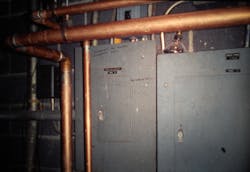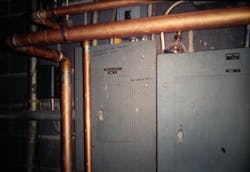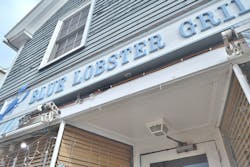What's Wrong Here? Hint: The Never-Ending “Space War” Continues
How well do you know the Code? Think you can spot violations the original installer either ignored or couldn’t identify? Here's your chance to moonlight as an electrical inspector and second-guess someone else's work from the safety of your living room or office. Can you identify the specific Code violation(s) in this photo? Note: Submitted comments must include specific references from the 2023 NEC.
Hint: The never-ending “space war” continues.
Tell Them What They've Won…
Using the 2023 NEC, correctly identify the Code violation(s) in this month's photo — in 200 words or less — and you could win an Arlington Industries 18-in. Slider Bar and plastic box for mounting between studs with non-standard spacing. E-mail your response, including your name and mailing address, to [email protected], and Russ will select three winners (excluding manufacturers and prior winners) at random from the correct submissions. Note that submissions without an address will not be eligible to win.
December Winners
Our lone winner this month was Ken Cunningham, an electrical design engineer for Moore Consulting Engineers, LLC, Shamong, N.J. He knew using extension cords as a substitute for the fixed wiring of a structure is not Code compliant.
Section 400.12(1) specifically prohibits this type of installation. Sec. 400.12(4) prohibits flexible cords, flexible cables, cord sets (extension cords), and power supply cords from being attached to building surfaces. Section 400.10(A) permits using flexible cords and flexible cables for only 11 applications, which are further restricted by Sec. 400.12. The use shown in this photo is not one of the uses permitted by Sec. 400.10(A). Chapter 3 wiring methods should be used here to provide a permanent wiring solution for providing power to the desired location.
About the Author

Russ LeBlanc
Owner
Russ started in the electrical trade as an apprentice in 1985. He worked his way up to become a Journeyman Electrician and then eventually became a Master Electrician and Licensed Construction Supervisor. In 1999 Russ become an Electrical Instructor for The Peterson School of Engineering in Massachusetts where he developed his passion for teaching, and quickly became Department Head of Electrical Instruction. Russ has taught thousands of apprentices, electricians, engineers, inspectors, and other electrical professionals during his career as an instructor. He continues to provide electrical professionals with Electrical Code seminars, Arc-Flash Awareness training seminars and educational material through his LeBlanc Consulting Services in North Reading, MA whose specialty is educating electricians. He has been an active member of the NFPA Electrical Section and has authored hundreds of National Electrical Code proposals and comments which have become Code rules to improve the safety for the electrical industry. Russ is also an IAEI certified Electrical Inspector.
Please visit www.russleblanc.net for more information.


